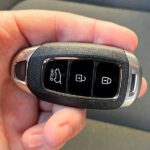Losing your car keys or needing a spare can be a frustrating and expensive experience. Traditionally, getting a new key for your Toyota meant a trip to the dealership and a hefty bill. However, with the advent of user-friendly key programmers, you can now take matters into your own hands and program a Toyota car key yourself. This guide delves into a real-world experience of using a Tom’s Key programmer, offering insights into the process and whether it’s the right solution for you.
One user decided to try out Tom’s Key programmer to avoid the dealership hassle. Upon receiving the programmer, they found it came with a prepaid return shipping label and a 30-day return window, offering peace of mind and a deposit-back guarantee. The process of programming both the key fobs and the keys themselves was reported to be straightforward. The programmer effectively erased existing programs and allowed for the addition of new keys.
The only minor issue encountered during the programming phase was with the new keys themselves. Initially, the programming process seemed to stall, spinning without completion. Troubleshooting led to the discovery that keeping other keys too close to the ignition switch might be the culprit. By ensuring other keys were at a distance, the programming became smoother. Even with this initial hiccup, programming two new uncut keys was ultimately successful, taking around 40 seconds on the second attempt after an initial failure. This highlights a potential tip for users: keep other keys away from the ignition area during the programming process to ensure a successful outcome.
After successfully programming the keys, the next step was getting them cut. This proved to be more challenging than anticipated. The user’s journey to get the keys cut involved multiple attempts at different locations, illustrating the common difficulties one might face. Starting with Lowe’s, they found themselves facing stock issues with type G keys. After purchasing keys online and returning to Lowe’s, they encountered malfunctioning machines and unhelpful staff who cited policies against cutting customer-provided keys. Home Depot presented similar roadblocks, with inexperienced staff and restrictive policies. Even a local hardware store, initially thought to be a reliable option, redirected them to a locksmith due to their inability to cut the specific keys.
Finally, the user found success at a local locksmith shop. Despite the inconvenience of weekend waiting and limited weekday hours (10:30-5:00 M-F), the locksmith efficiently cut both keys in just five minutes for a reasonable $10 fee. The newly cut keys worked flawlessly in their Toyota Tundra. This part of the experience underscores the importance of considering key cutting services and potentially researching local locksmiths beforehand to avoid unnecessary delays and frustrations after the programming stage.
In conclusion, based on this firsthand experience, Tom’s Key programmer comes highly recommended for those seeking a DIY solution to program Toyota car keys. It eliminates the complexities and potential risks associated with purchasing separate programmers and potentially unreliable software. While users might wish for the advanced configuration options offered by professional tools like Techstream, Tom’s Key programmer provides a user-friendly and effective way to program new keys and fobs. The main takeaway is that while the programming itself can be straightforward, getting the keys physically cut might require patience and resourcefulness, potentially involving visits to multiple key cutting services before finding a suitable solution, like a local locksmith. For those prioritizing convenience and a guided process for key programming, Tom’s Key service appears to be a worthwhile option.
